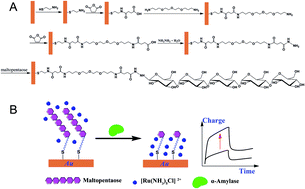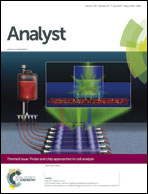A novel electrochemical method to determine α-amylase activity†
Abstract
In this paper, we report a novel electrochemical method that can be developed as a biosensor for simple and direct determination of α-amylase activity. The method is based on the hydrolysis of maltopentaose, the substrate of the enzyme, which is immobilized on the surface of a gold electrode, and the induced charge changes of the substrate-modified electrode. Specifically, the substrate maltopentaose is immobilized onto a gold electrode surface via a simple and direct immobilization technique that involves a one-step and site-specific attachment of unmodified maltopentaose to the hydrazide-derivatized surface. So, by analyzing the electrochemical signal obtained from the electro-active molecule [Ru(NH3)5Cl]2+ during the hydrolysis of maltopentaose, the determination of α-amylase activity is achieved. Under optimized conditions, α-amylase activity can be assayed with a detection limit of 0.022 U mL−1. The biosensor exhibits a rapid response, good stability and anti-interference ability. Furthermore, the biosensor has also been successfully applied to detect α-amylase in human serum, which shows acceptable accuracy compared to the currently used clinical method. The proposed method in this work may also have potential application of α-amylase determination in real blood samples, diagnostics and food production in the future.


 Please wait while we load your content...
Please wait while we load your content...